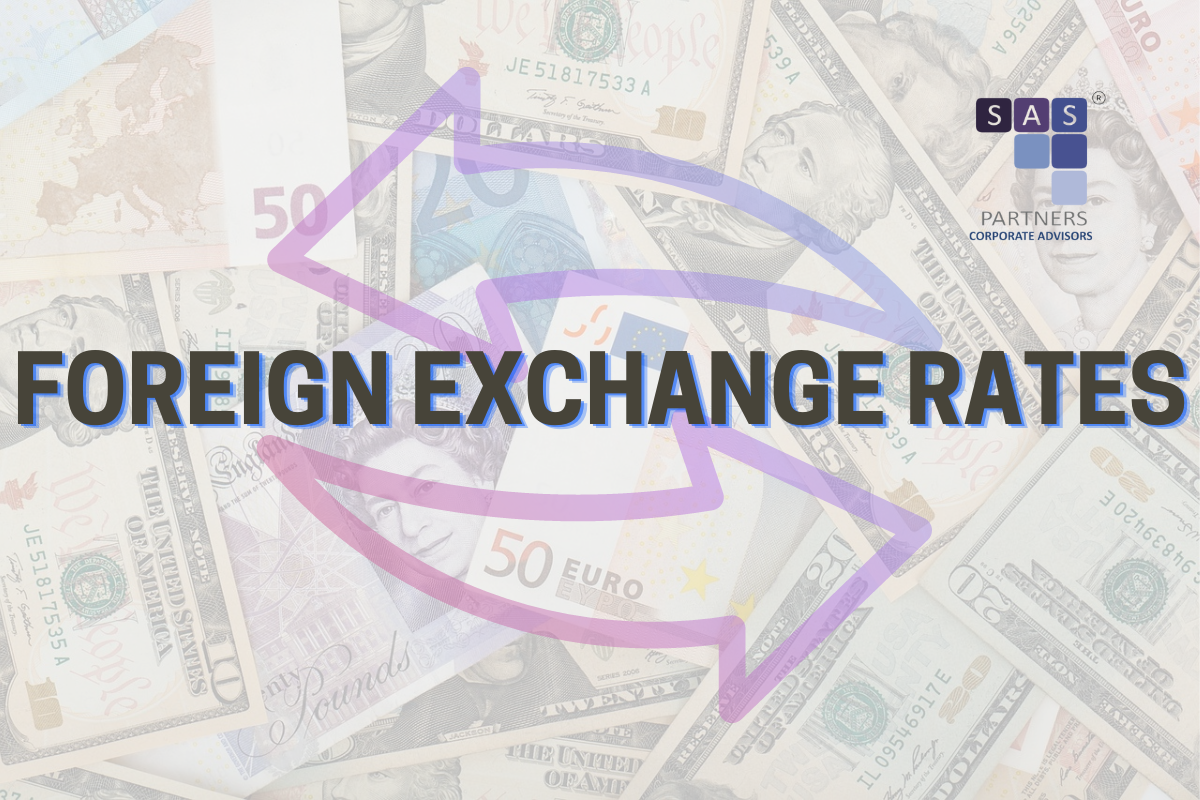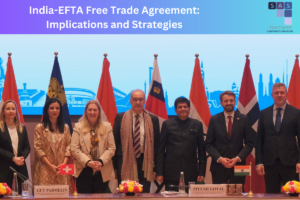
INDIAN ECONOMY – FOREIGN EXCHANGE RATES
Introduction
A forex rate is nothing but the relative value between a pair of currencies. The rate could be between the currencies of any two countries such as the USD and Euro or USD and INR and so on. What has caused concern among central banks across the world is the huge appreciation of the dollar as against many major currencies.
The appreciation of the USD against other currencies this year has hit a 20-year record and is unprecedented. Let’s look at how some major currencies have depreciated against the USD in the last year:
| Euro Area | -17.9% |
| India | -9.89% |
| United Kingdom | -21.14% |
| Japanese Yen | -29.99% |
| Australian Dollar | -12.93% |
On the flip side, the currencies of countries like China, Brazil, and some other Latin American countries actually appreciated against the dollar. The International Monetary Fund (IMF), on its website states as follows:
“The dollar is at its highest level since 2000, having appreciated 22 per cent against the yen, 13 per cent against the Euro and 6 per cent against emerging market currencies since the start of this year. Such a sharp strengthening of the dollar in a matter of months has sizable macroeconomic implications for almost all countries, given the dominance of the dollar in international trade and finance.”
Quoting what the Finance Minister of India said, the depreciation of the Indian Rupee had nothing to do with the Indian economy which was still growing at a decent rate. It had more to do with global developments in geopolitics and geoeconomics.
Appreciation of the US Dollar
Currency appreciation is nothing but the increase in value of one currency against another currency. Currencies of nations can appreciate or depreciate depending upon a number of economic and political factors such as inflation, interest rates, government policies, balance of trade, and other related issues.
To better understand how currencies are valued, it is important to have an idea of the economic factors that determine currency rates. Generally, currencies are described either as fixed rate or floating rate. Countries that have a fixed rate are those where the central banks or monetary authorities of that country determine or control the exchange rate. It does not change or fluctuate. Floating rates are determined by the currency markets and are constantly changing depending on the demand and supply of a particular currency. The central banks of countries with floating exchange rates cannot control the rates but do intervene by buying or selling currencies depending on the economic situation. The US Dollar is the currency most in demand for a number of reasons.
Demand for the US Dollar
It is common knowledge that over 60 percent of international trade is denominated in US Dollars. This automatically makes the dollar the currency that is most in demand across the business world. This, in turn, results in most countries holding their foreign exchange reserves in dollars. China alone has over three trillion dollars in reserve currency. India, before the appreciation of the dollar, had over 600 billion in dollar reserves. This has come down by over a hundred billion due to the Reserve Bank of India trying to sell dollars in the open market to restrict the depreciation of the rupee against the dollar.
The recent geopolitical developments related to Russia and Ukraine resulted in the prices of energy, especially oil and gas, shooting up. This happened because sanctions were placed on Russia which is one of the world’s biggest suppliers of oil and gas. And Ukraine is one of the biggest exporters of wheat and sunflower oil. The war resulted in a shortage of energy and essential food items like wheat and edible oil. The huge surge in prices resulted in demand for dollars which were required to pay by the importing countries. Since most countries import food and energy, they had no alternative but to pay the higher prices, which in turn increased the demand for dollars. The sudden demand for USD automatically led to the appreciation of the dollar against many of the world’s largest economies. To give a very simple example, the Euro, which was launched in 2001, was always quoted around 15% to 20% above the dollar. The Euro now has a value lower than the dollar.
Risk and Stability
There are many other factors that determine the value of a currency besides demand. Risk and stability of a currency are very important factors that affect a currency’s value. It is well known that central banks of countries store foreign currencies and gold as reserves as a safety net. As mentioned earlier, the USD is seen as a safe currency because of its relative stability as compared to other currencies and because international trade payments are made in American dollars. Keeping dollar reserves reduces the risk of a country’s currency reserves depreciation in value. And both, the USD and gold have always lived up to their reputation as safe investments for reserves.
Crisis & Uncertainty
A crisis situation like the invasion of Ukraine leads to huge uncertainties in economies all over the world. Neither governments nor businesses like uncertainty. As a result of Russa’s invasion of Ukraine and the resulting problems with energy and foodgrain shortages, there is insecurity and a complete lack of confidence as to what the future will look like in terms of economic growth and energy and food prices. This has resulted in a scramble for a safety net that will reduce the impact of the economic downturn. And this has led again to a rise in demand for the American dollar which continues to be stable and has increased in value against many currencies in these uncertain terms.
Rising American Interest Rates
From mid-June to November, the Federal Reserve in the USA has increased interest rates for 4 consecutive times this year at an unprecedented rate on 0.75% each time. This has raised the borrowing rates in the USA to over 4% which is something that has not happened for quite a few years. This has resulted in the appreciation of the dollar. The American dollar has, as we have seen earlier, appreciated considerably against a number of currencies. Part of the reason is the rise in interest rates. When interest rates rise, investors and companies move their investments from low yielding or risky countries or regions to high yielding and stable economies. This has now resulted in investments, especially is stocks, being shifted out of emerging markets to the USA due to the higher interest rates, lower risks and a stable and appreciating currency. With more money flowing into the USA, the dollar becomes even more stronger.
Implications for India & Emerging Markets
A strong dollar is not good for emerging economies like India. It has many detrimental effects. Here are some of the ways in which the appreciation of the dollar can affect a country like India.
- India’s foreign exchange reserves, which were at an all-time high at USD 645 billion in October 2021 have declined to 471.496 billion in October 2022. This is because of the appreciation of the dollar, the RBI selling dollars to protect the rupee from depreciating too much and the higher prices the country has to pay for imports of oil, gas and other goods and services. The large reduction in India’s foreign exchange reserves is a cause for concern and can affect the economy.
- India imports more than 80% of its oil and gas requirements. With the massive increase in oil and gas prices and the appreciation of the dollar, which is the mode of payment, India’s import bill has risen tremendously and may continue to rise.
- High oil prices will affect the prices of Indian goods as most of India’s manufactured products are transported by road and with diesel prices very high, the burden will be passed on to the consumers.
- India, like many other emerging economies imports much more that it exports. This means more foreign currency is going out of the country than coming in. This is known as the trade balance. The trade balance is the difference between the value of imports and the value of exports. India has always had a negative trade balance and this will worsen due to the appreciation of the dollar.
- Indian exporters will benefit from the appreciating dollar as they will now receive higher rates when their payments are converted into rupees.
- Indian importers, especially of capital goods, will face higher prices and this would mean that they will either postpone their purchases or pass on the higher prices to their consumers. The same will happen with consumer goods. This in turn will lead to even higher inflation, which is already very high.
- High inflation will result in the Reserve Bank of India further increasing interest rates. This will lead to reduced borrowing and slowdown in investments. Lower investment will affect the economy’s growth leading to the GDP dropping. The IMF and the World Bank have already projected lower economic growth for next year and India’s GDP growth is expected to come down to 6.1 or 6.5% next year.
- Countries that have large debts from abroad will face difficulties in servicing their debts due to the appreciation of the USD as the debts will become more expensive. The same applies to companies that have borrowed from institutions abroad. This can put many poor and emerging economies and their companies in great difficulty.
- The IMF has predicted that global economic growth will come down to 2.7% in 2023 compared 3.2% in 2022 and 6.0% in 2021. This is the lowest growth rate since 2001.
The appreciation of the USD is bad news for developing and developed countries, it is very clear that the world is going through economic hardships and this will continue well into next year. The Russian invasion of Ukraine has impacted the global economy negatively. Inflation has become widespread, interest rates have risen in most countries, energy prices, especially gas prices in Europe have gone through the roof resulting in what has been termed “energy poverty”. Demand for goods and services is on a downward trend, slowing economic growth. These are tumultuous times for the global economy and the appreciation of the USD against most major currencies will only cause more trouble. There are no easy solutions to the problem and it may take years for global economic growth to stabilize and return to normalcy.
About the Author
 |
VIJAY KUMAR VADDADI, India Entry & International Affairs
Mr. Vijay Kumar is an Industrial Economist with 35+ years of experience in Economic Analysis, Trade & Investment Promotion, International Business Strategy & Cross-Cultural Impact. A Post-Graduate in Economics with specialization in Industrial Economics and Economics of Transportation, Public Utilities & Social Infrastructure from the University of Bombay (1982). In 1984, he joined the Consulate General of the Netherlands in Mumbai as Economic & Commercial Officer and continued his association with the Netherlands Government (NBSO) for over 30 years. At SAS Partners, he heads the Trade and Investment Promotion activities, supports in organising programmes for international business delegations, curating knowledge reports, market studies and also helps our international clients in understanding the Indian business landscape better. |



